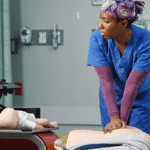“It’s just a toothache and I really wish everyone would stop making it such a big deal!” spouted off the feisty 78 year old woman sitting in triage. Her “toothache” began sometime during the night and she figured she’d see a dentist in the morning. Fortunately her daughter followed her “gut instinct” that this was something more. It was….she was having a heart attack.
What Is a Heart Attack?
A heart attack occurs if the blood flow that carries oxygen to the heart is reduced or cut off completely. This may happen if the coronary arteries that pump blood to the heart become narrow due to a build-up of fat or other substances.
According to the American Heart Association (AHA), a heart attack affects someone in the United States about every 40 seconds. Conversely, individuals who know how to identify heart attack symptoms may be able to mitigate the effects of a heart attack quickly.
Women are a little unique when it comes to recognizing the symptoms of a heart attack. The hallmark symptoms of chest pressure, shortness of breath, arm pain, neck pain, nausea and/or dizziness may occur, which is the standard watch-list for suspicions of cardiac injury. However, women generally experience other symptoms which may not be as easily recognized for being related to heart distress.
As in the case above where the elderly woman did not associate a “toothache” with her heart, frequently minor symptoms are mistaken for other problems when the cardiac event occurs. Symptoms such as earlobe pain, shoulder pain, back pain, elbow or arm pain and stomach ache are also associated with cardiac injury for women. Pair these with a history of diabetes, high cholesterol, obesity, smoking, menopause and a family history of cardiac illness and you have the perfect mix of “red flag” symptoms for cardiac injury, MI (myocardial infarction) or ischemia – aka: heart attack.
How to Aid a Heart Attack Victim
Let’s face it – a heart attack is a terrifying situation. But if you understand how to aid a heart attack victim, you may be able to prevent the loss of life.
Anyone can become a life-saver, and Mayo Clinic offers the following steps to assist a heart attack victim:
- Call 911.
When it comes to a heart attack, it is always better to err on the side of caution. If you believe a friend, family member or neighbor is suffering a heart attack, call 911.
While calling 9-1-1 to activate first responder assistance isn’t always appropriate with usual every-day symptoms typical of baseline “aches and pains” or the “flu”, placing that 9-1-1 call is always appropriate when these symptoms are atypical or of sudden onset, generally unusual. When in doubt, seek help. The health care professionals will assess, triage and initiate appropriate action based on ACLS protocols and hospital protocols. Paying attention to a symptom as a woman can save your heart injury and possibly save your life.
As a woman, paying attention to heart attack symptoms can possibly save your life. For instance, perhaps the unusual “ache” is really your heart crying out for help – the help received from trained healthcare professionals. Consider the combination of contributing factors (symptoms and medical and family history) the next time you feel a toothache. You may just decide to visit the ER – and not your dentist.
Perhaps the unusual “ache” is really your heart crying out for help – the help received from trained health care professionals. Consider the combination of contributing factors (symptoms, medical and family history) the next time you feel a toothache. You may just decide to visit the ER…and not your dentist.
- Administer Cardiopulmonary Resuscitation (CPR)
CPR training can make a world of difference, especially for heart attack victims. If you become CPR-certified, you may be able to help a heart attack victim at any location, at any time.
In many instances, hands-only CPR empowers individuals of all ages to deliver life-saving support. This form of CPR requires only two steps:
- Call 911 or send someone to call 911 for you.
- Push hard and fast on the center of the chest.
With hands-only CPR, an individual will need to deliver chest compressions to a heart attack victim at a rate of 100 to 120 beats per minute, the AHA points out. By doing so, an individual can dramatically increase a heart attack victim’s chances of survival.
Furthermore, CPR certification classes are available year-round. These courses ensure anyone can learn how to perform adult, child and infant CPR, assist conscious and unconscious choking victims and much more.
- Use an Automated External Defibrillator (AED)
An AED is a medical device that analyzes a person’s heart rhythm and can provide an electrical shock to help an individual reestablish an effective rhythm. It also may prove to be the difference between life and death for a heart attack victim.
If a heart attack victim is unconscious, an individual can begin CPR while an AED is set up. Then, a person should follow the instructions provided by the AED after it assesses a heart attack victim’s condition.
A CPR certification class enables a person to get an up-close look at an AED and find out how the device works. In addition, the class ensures an individual can receive expert CPR and AED training from medical personnel who have provided life-saving support to heart attack victims.
Want to help heart attack victims? Use the aforementioned tips, and you can assist a heart attack victim until advanced medical personnel become available.










